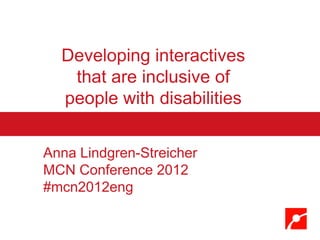
Developing interactives that are inclusive of people with disabilities
- 1. Developing interactives that are inclusive of people with disabilities Anna Lindgren-Streicher MCN Conference 2012 #mcn2012eng
- 2. Universal Design, Universal Design for Learning
- 3. The Creating Museum Media for Everyone project (CMME) “…further the field’s capacity to design, develop and implement innovative digital interactives for science museum exhibitions that engage people with and without disabilities in informal science learning.”
- 6. Understanding data through sonification & touch
- 7. Understanding data through sonification & touch
- 8. Multi-touch table audio layer
- 9. Personalizing the museum experience
- 10. What we learned about running workshop/hackathon • Intensive workshops which bring many people together and challenge them to be creative can lead to new and interesting ideas • Participants need common background information • People with disabilities should be included in the design process from the beginning • Personas can be a useful tool for keeping end-users in mind • Varying forms of documentation are important for project’s records and dissemination purposes
- 11. More MOS work – UD touchscreens
- 12. More MOS work – UD touchscreens
- 13. Questions? alstreicher@mos.org @astreichs http://openexhibits.org/research/cmme/
- 14. Credits • Museum of Science: Christine Reich (PI), Andrea Durham (co-PI), Anna Lindgren-Streicher, Ben Wilson, Keith Simmons, Boob Rayle, Marta Beyer, Stephanie Iacovelli • Ideum: Jim Spadaccini (co-PI), Charles Veasey • WGBH NCAM: Brad Botkin (co-PI), Larry Goldberg, Madeline Rothberg This presentation was based on work supported by the National Science Foundation under Grant No. 0532536. Any opinions, findings, and conclusions or recommendations expressed in this presentation are those of the authors and do not necessarily reflect the views of the Foundation.
Editor's Notes
- Universal design from architecture and product design, UDL from formal educationPhysical, cognitive, and social inclusionMultiple, flexible methods of representation, expression, engagementBeen thinking about it for ~25 years at the MOS, but have realized that we’re not keeping up with the latest challenges related to computer-based interactive exhibits (touchscreens, multi-touch tables, kinect-based interactives, etc.)
- Collaboration with Ideum, National Center for Accessible Media at WGBHNSF-funded
- An opportunity to:Learn about the project’s goalsLearn from leaders in other fieldsExperiment with the latest technologyBrainstorm ideas about information-based technology interactivesAreas of presentation:Designing in the museum environment, UD/UDL, disability theories & models, personalized experiences, emotion and learning, gamification for people with disabilities, needs of specific groups in museums, user evaluation, data sonification
- the team developed a vibrating puck that would provide tactile feedback. According to the different levels of vibrating feedback, visitors would be able to feel how the data points were spread out in a space and where their particular measurement was located. 4 different vibrating modes in this prototypeHad brainstormed about the types of tactile sensations, aesthetics of the different sensations, and what was technically feasibleWanted visitors to be able to pick out points, trends, and quantities One thing they considered was how big a space visitors would explore at the exhibit and how people with limited mobility would use exhibit. Assumed that there would be audio and visual elements as well.By moving the tactile slider, a visitor’s hand would travel along the x and y axis of a graph simultaneously triggering different types of pitches corresponding to data points. The team was able to use code developed by Georgia Tech’s Sonification Lab, to provide an auditory indication to a visitor of trends within the data or where their own data point was located.
- Challenge to add an audio layer to a dynamic moving environmentThought about various approaches for audio layer approaches:RFID tags/bar cods—own personal preferencesPush-button interfaceTactile elementsGesture basedFiducial/object triggered
- While all of these approaches had Universal Design in mind, there are situations when people have particular needs. This group focused on the broader issue of what a personalized museum experience might look like—giving everyone the option to optimize their experience. Variables that visitors might want to personalize:LanguageText size or colorImage sizeVideo and audio descriptionsVolume and audio settingsAmount of time given for an activityLevel of contentAbility to use a personal deviceFurther areas to explore:Actual implementation of personalization options at museumsEffect of budget constraintsWhen and where visitors would answer these questionWhat personalization means when multiple visitors are collaboratingTypes of cognitive support museums could offer